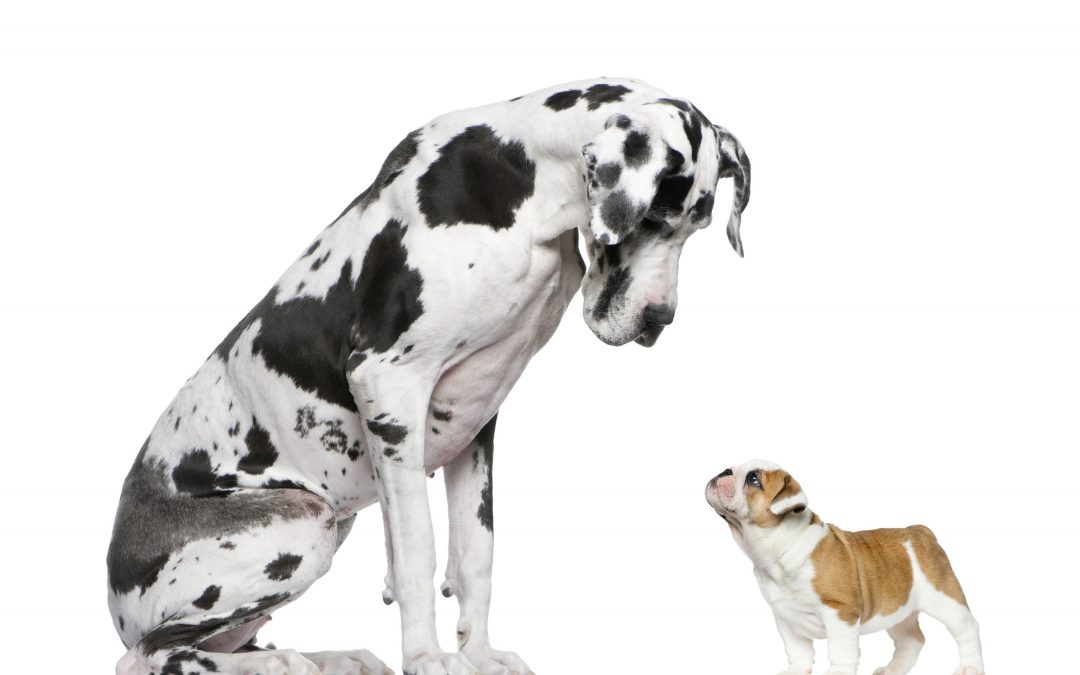If you’ve just gotten a new puppy, congratulations! And if you have an older dog in the house, you’ll want to be sure that your old and new pups get along well. Learning how to introduce a new puppy to an older dog can be challenging, but the rewards are great.
The effort it takes to help your new puppy get along with your older dog will be worth it in the long run. Your dog and your pup will eventually form a bond that will last for years.
The best way to help the introduction between the pup and adult go smoothly is planning. Introducing a puppy to an adult dog takes some thought. You’ll also need plenty of patience and a lot of love. Here are some tips to help you prepare.
Respect Your Adult Dog’s Feelings
You might have had your adult dog for several years. They’re probably used to having a lot of attention, love, and play time. It’s important to keep that love flowing when you bring the new pup home.
It may take time for your older dog to come around. Don’t expect your dog and the puppy to get along famously immediately.
That’s not to say it can’t happen, just don’t assume that’s going to be the case.
Your resident dog might be easygoing, but that doesn’t mean that things will go smoothly when you introduce the new pup. Your dog may get along fine with other dogs in the neighborhood, or even the cat! But that doesn’t guarantee instant success.
Give Positive Reinforcement
Introducing a new puppy to an adult dog will test your patience, but try to always stay positive. Have plenty of treats ready to reward good behavior. Positive reinforcement should be your top priority!
Never punish the adult dog. As the dominant dog, it’s only natural for them to show some possessive, dominant behaviors at first. Growling, for example, is a warning. If you punish either the puppy or dog for this behavior, they might eventually bite without giving that warning. The dog may feel it’s not safe to growl if they associate punishment with this type of natural dog behavior.1
Positive reinforcement can teach them to behave and (eventually) accept the pup.

The First Meeting
Introducing a puppy to an adult dog is best done on neutral ground. If possible, have someone bring your dog to a neighbor’s yard. Then bring the young puppy to the meeting spot. Keep both animals on a leash during the first meeting.
Be on the lookout for any signs of canine aggression. Signs of negative body language include:
- Hunching of backs
- Staring for long periods of time
- Raised fur on the back or neck
- Showing teeth
- Growling2
Separate the pup and adult if either of them starts to exhibit aggressive behavior. Wait a few minutes, and then try again. Have treats handy to reward good behavior, and try to play with each dog.
You should also be on the lookout for positive body language. If the pup and adult greet each other with their tails up and their front ends lowered, that’s a sign they want to play! 3
Settling in at Home
You’ll want to keep the dogs separated for a few weeks after you bring the pup home. Both can take turns being in their respective crates or in separate rooms. Make sure you play with each dog and give them plenty of attention.
Crate Training
Crate training should start slow. Don’t keep your new puppy in a crate unattended for long periods of time. Crate training is a low adjustment and should be done under careful supervision. A crate should feel like a safe space, not a jail.
Once your pup is properly crate trained, you can keep him or her in a dog crate at night and when you’re not home.
This helps ensure their safety, and it will also help with training.
It gives your new puppy a safe space to rest, and it helps keep them from infringing on your older dog’s territory when you’re not around.
Also, keep one of your adult dog’s blankets in the crate. You might also want to put one of their toys in the crate, too. This will help the new pup get used to the other’s dog’s scent.

General Training
It’s important to keep a training program going while both dogs get used to each other. You’ll need to continue potty training, as well as other forms of training during this time. Do this in a separate room. Use a baby gate to keep the dogs away from each other.
Keep a Close Watch
Supervise all interactions between the dogs carefully. Keep them on a leash for a few days when they’re both in the same room. If they seem calm, or seem like they want to play, take them off the leash.4
Talk to Your Vet
When it comes to how to introduce a new puppy to an older dog, there are lots of things to do. There’s crate training, behavioral training, and much more. You’ll also have to teach both your puppy and adult dog how to get along. It takes time, but you’ll get there.
If you have any problems with threatening body language, aggression, or anything else, talk to your vet. They can recommend other things that might help the two animals get along. Your vet may refer you to someone who specializes in dog behavior if you need more extensive help.
Learn More:
How to Introduce Cats to Each Other
Why Does My Dog Drink Out Of The Toilet? (& how to break the habit)
Remarkable Jobs for Dogs: Therapy, Working, and Service Dogs
Sources
1.https://www.whole-dog-journal.com/behavior/5-steps-to-deal-with-dog-growling/
2.https://www.rover.com/blog/introduce-new-puppy-older-dog/
3.https://moderndogmagazine.com/articles/how-read-your-dogs-body-language/415
4.https://indoorpet.osu.edu/dogs/new_additions_dogs/dog-dog-intro































